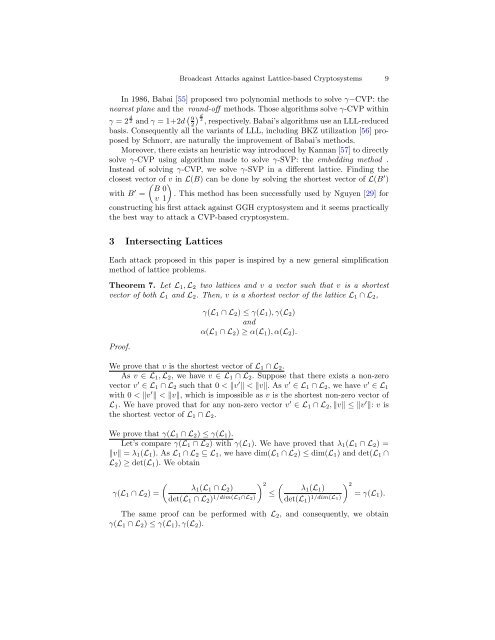Broadcast Attacks against Lattice-based Cryptosystems*
Broadcast Attacks against Lattice-based Cryptosystems*
Broadcast Attacks against Lattice-based Cryptosystems*
You also want an ePaper? Increase the reach of your titles
YUMPU automatically turns print PDFs into web optimized ePapers that Google loves.
<strong>Broadcast</strong> <strong>Attacks</strong> <strong>against</strong> <strong>Lattice</strong>-<strong>based</strong> Cryptosystems 9In 1986, Babai [55] proposed two polynomial methods to solve γ−CVP: thenearest plane and the round-off methods. Those algorithms solve γ-CVP within) dγ = 2 d 2 and γ = 1+2d ( 9 22, respectively. Babai’s algorithms use an LLL-reducedbasis. Consequently all the variants of LLL, including BKZ utilization [56] proposedby Schnorr, are naturally the improvement of Babai’s methods.Moreover, there exists an heuristic way introduced by Kannan [57] to directlysolve γ-CVP using algorithm made to solve γ-SVP: the embedding method .Instead of solving γ-CVP, we solve γ-SVP in a different lattice. Finding theclosest vector ( of)v in L(B) can be done by solving the shortest vector of L(B ′ )B 0with B ′ = . This method has been successfully used by Nguyen [29] forv 1constructing his first attack <strong>against</strong> GGH cryptosystem and it seems practicallythe best way to attack a CVP-<strong>based</strong> cryptosystem.3 Intersecting <strong>Lattice</strong>sEach attack proposed in this paper is inspired by a new general simplificationmethod of lattice problems.Theorem 7. Let L 1 , L 2 two lattices and v a vector such that v is a shortestvector of both L 1 and L 2 . Then, v is a shortest vector of the lattice L 1 ∩ L 2 ,Proof.γ(L 1 ∩ L 2 ) ≤ γ(L 1 ), γ(L 2 )andα(L 1 ∩ L 2 ) ≥ α(L 1 ), α(L 2 ).We prove that v is the shortest vector of L 1 ∩ L 2 .As v ∈ L 1 , L 2 , we have v ∈ L 1 ∩ L 2 . Suppose that there exists a non-zerovector v ′ ∈ L 1 ∩ L 2 such that 0 < ‖v ′ ‖ < ‖v‖. As v ′ ∈ L 1 ∩ L 2 , we have v ′ ∈ L 1with 0 < ‖v ′ ‖ < ‖v‖, which is impossible as v is the shortest non-zero vector ofL 1 . We have proved that for any non-zero vector v ′ ∈ L 1 ∩ L 2 , ‖v‖ ≤ ‖v ′ ‖: v isthe shortest vector of L 1 ∩ L 2 .We prove that γ(L 1 ∩ L 2 ) ≤ γ(L 1 ).Let’s compare γ(L 1 ∩ L 2 ) with γ(L 1 ). We have proved that λ 1 (L 1 ∩ L 2 ) =‖v‖ = λ 1 (L 1 ). As L 1 ∩ L 2 ⊆ L 1 , we have dim(L 1 ∩ L 2 ) ≤ dim(L 1 ) and det(L 1 ∩L 2 ) ≥ det(L 1 ). We obtain() 2 () 2λ 1 (L 1 ∩ L 2 )λ 1 (L 1 )γ(L 1 ∩ L 2 ) =≤= γ(Ldet(L 1 ∩ L 2 ) 1/dim(L1∩L2) det(L 1 ) 1/dim(L1) 1 ).The same proof can be performed with L 2 , and consequently, we obtainγ(L 1 ∩ L 2 ) ≤ γ(L 1 ), γ(L 2 ).
















